St. Giles
At the termination of the Lawnmarket, George IV. Bridge diverges on the south, and Bank Street on the north — the first leading past the Sheriff Court House to the Industrial Museum, etc., and the second affording an access to Princes Street by the Mound, and taking its name from the Bank of Scotland, which is the principal and oldest bank in Scotland, having been projected originally in 1695. The present edifice is a renovation of the original structure, from a plan by the late David Bryce, R.S. A.
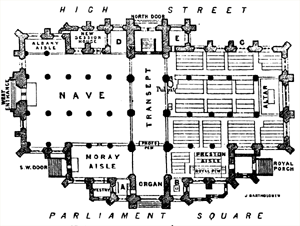 A little below we reach St. Giles's Cathedral, the ancient Parish Church(1) of Edinburgh, named after St. Giles, abbot and confessor, and Patron Saint of the City. His arm, enshrined in silver, and long preserved among the relics of the church, was one of those seized by the magistrates at the Eeforma- tion. The present church is the erection of various periods, and is the most ancient in the city, although its clean polished exterior ( the result of an unfortunate restoration in 1829) would rather seem to belie the fact.
A little below we reach St. Giles's Cathedral, the ancient Parish Church(1) of Edinburgh, named after St. Giles, abbot and confessor, and Patron Saint of the City. His arm, enshrined in silver, and long preserved among the relics of the church, was one of those seized by the magistrates at the Eeforma- tion. The present church is the erection of various periods, and is the most ancient in the city, although its clean polished exterior ( the result of an unfortunate restoration in 1829) would rather seem to belie the fact.
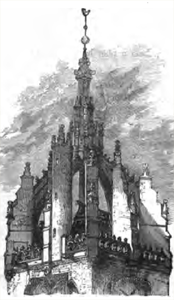 The interior has undergone extensive alterations, and now appears much in its pre-Keformation state. This great work was accomplished mainly at the instance, and almost wholly at the expense, of the late Dr. William Chambers, the well-known publisher. The spire of the Cathedral is in the form of an octagonal lantern, and exhibits those irregularities found in 'the finest specimens of Gothic work.
The interior has undergone extensive alterations, and now appears much in its pre-Keformation state. This great work was accomplished mainly at the instance, and almost wholly at the expense, of the late Dr. William Chambers, the well-known publisher. The spire of the Cathedral is in the form of an octagonal lantern, and exhibits those irregularities found in 'the finest specimens of Gothic work.
The Choir is fitted up with oaken stalls for the judges and magistrates, who attend divine service in their robes on special occasions. The aisle to the south is named after Preston of Gorton, who bequeathed to the church the arm-bone of St. Giles, which lie had acquired by the assistance of the King of France. Adjoining it (marked B on the ST. GILES'S 15 plan) is the small chapel founded by plan) is the small chapel founded by Chepman, the "Scottish Caxton," where also the remains of the great Marquis of Montrose were interred, eleven years after his execution, which took place in Edinburgh in 1650.
The Nave — the latest restored portion of the building — contains the Moray and Albany aisles, the former of which is fitted up as a separate chapel, containing (A in plan) the tomb of the Regent Moray, who was interred here immediately after his assassination at Linlithgow, when the funeral sermon was preached by John Knox. Along the roof are the well-worn colours of Scottish regiments, placed there for preservation in 1883. The Albany aisle contains a pillar decorated with the arms of Robert, Duke of Albany, and Archibald, fourth Earl of Douglas, who are supposed to have founded this chapel as an expiatory offering for the murder of the Duke of Rothesay ( eldest son of Robert III.) at Falkland, in 1402.
The history of St. Giles's is one of national interest. Originally the city consisted of one parish, and St. Giles's Church was the only place of worship. It is first mentioned in the year 1259, in a charter of David II., and in the reign of James III. (1466) it was made collegiate, and placed in some respects under the direct jurisdiction of the Pope, with Provost and Chapter. The Scottish poet, Gavin Douglas, was elected Dean or Provost in 1501. After the Reformation the church was greatly disfigured (as were many sacred edifices at that time), partitioned into four places of worship, and the sacred vessels and relics were sold by the magistrates to defray the expense of the alterations. In 1603, before the departure of James VI. to take possession of the throne of England, he attended divine service in St. Giles's, and delivered a farewell address to his Scottish subjects, assuring them, of his unalterable affection. With the establishment of Episcopacy in Scotland under Charles I., Edinburgh was erected into a bishopric, and St. Giles's Church was appointed the Cathedral — a distinction which departed with the abolition of Episcopacy in 1638. An attempt made in 1636 to introduce the new "service-book" of Charles I. led to the ludicrous scene when Jenny Geddes threw her cutty-stool at the Dean of Edinburgh (by name Hannay)(2) ,0n the 13th October 1643 the Solemn League and Covenant, which had been prepared by Alexander Henderson, was sworn to and subscribed withih the walls of this ancient and interesting church.
On the outside of tlie north wall there is a monument to Napier of Merchiston, the inventor of logarithms. At the north-west corner of the church formerly stood the Old Tolbooth gaol, " The Heart of Midlothian," immortalised in Scott's novel of that name. The position is indicated by the figure of a heart oil the causeway.
Originally the ground now occupied by Parliament Square and part of the Parliament House was the ancient churchyard, where many notable men were interred, including John Kuox, whose grave is marked by a small stone near the statue of Charles II., and inscribed I. K., 1572. The equestrian statue of Charles II. is a well-executed work in lead, representing that monarch in the Roman dress. It was erected at the expense of the city, in 1680, twenty years after the Restoration, on a spot said to have been intended for a statue of Cromwell, which gave occasion to the following couplet: —
" But civic sycophants,— a courtly tool,—
Bartered stone Cromwell for a Charles of lead."
THE CROSS.
In the east division of the Square stands "Dun-Edin's Cross, a pillar'd stone," being the restored Market Cross of the city, the original of which stood in the immediate vicinity. This restored relic was the gift of the Right Hon. W. E. Gladstone, who had the satisfaction of witnessing its completion in December 1885. The building is octagonal, surmounted by turrets, and having a door ( admitting to the top) on its east side. From the centre rises the original shaft or pillar (surmounted by the heraldic unicorn), which had been carefully preserved after the destruction of the previous erection in 1756.
From the Cross the Scottish Heralds and Pursuivants (Rothesay, Albany, Marchmont, Unicorn, Carrick, and Bute) are wont, as of old, to proclaim royal edicts
" In glorious trumpet clang."
THE PARLIAMENT HOUSE,
the ancient meeting-place of the Scottish Parliament, has been Appropriated since the time of the Union to the use of the Supreme Courts. The present building was erected between the years 1632 and 1640, but subsequently, with the exception of the great hall, almost totally renewed. The public entrance is at the south-west angle of the square, and there is free admission. The great hall or Parliament House (122 ft. by 49, with a lofty roof of carved oak) was finished in 1639. It is ornamented with statues and portraits of distinguished lawyers more or less connected with Scotland, the principal of whom are Forbes of Culloden(3) Viscount Melville, Dundas of Arniston, Blair of Avonton, Francis Jeffrey, Boyle, and Cockburn.
Among the portraits are the following : — Lord Brougham ; Lords Presidents M'Neill, Hope, and Inglis ; John, Duke of Argyle and Greenwich ; Lord President Lockhart of Carnwath, and numerous other distinguished legal functionaries, whose names are inscribed on the frames. The subject of the Stained Glass Window, on the south side of the hall, is the inauguration of the Court in 1537 by James V., who is in the act of presenting the deed of confirmation by Pope Clement VII. to the Lord President. The other figures represent Dunbar, Archbishop of Glasgow, the Abbot of Cambuskenneth, and judges and nobles of the time. This window was executed at Munich in 1868, from a design by Kaulbach, and cost £2000.
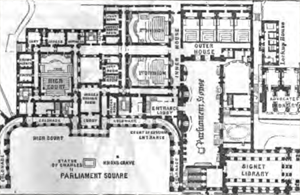 The Outer House, where the Lords Ordinary sit, is reached from below this window, and consists of four small courts, where civil cases are tried for the first time. The Inner House is divided into two divisions (First and Second), where appeals are heard from the Outer House and Sheritf-Courts. The High Court of Justiciary is the supreme criminal tribunal of Scotland, and is situated in another part of the building.
The Outer House, where the Lords Ordinary sit, is reached from below this window, and consists of four small courts, where civil cases are tried for the first time. The Inner House is divided into two divisions (First and Second), where appeals are heard from the Outer House and Sheritf-Courts. The High Court of Justiciary is the supreme criminal tribunal of Scotland, and is situated in another part of the building.
The legal profession is divided into the following classes : — 1. Thirteen Judges of the Court of Session, styled LORDS OP SESSION. 2. ADVOCATES (barristers), who possess the privilege of pleading before every court in Scotland, and also in Scotch appeals before the House of Lords. 3. WRITERS TO THE SIGNET, and SOLICITORS BEFORE THE SUPREME COURTS (similar to attorneys or solicitors in England), ADVOCATES' FIRST CLERKS, and SOLICITORS-AT-LAW. These three classes form the College of Justice.
Connected with the Parliament House is
THE ADVOCATES' LIBRAKY
(access to which is obtained through the great hall of the Parliament House), one of the five libraries in the United Kingdom entitled to a copy of every book published in Great Britain. A large additional library hall was opened in 1884.
This library contains the most valuable collection of books in Scotland, the printed works amounting to some 300,000 volumes, STATUE OF FORBES OF CULLODEN, BY ROUBILIAC. including exceedingly rare and curious works in Scottish poetry, of which there is a printed catalogue, extending to seven quarto volumes (1867-79). The manuscripts are extensive, and readily accessible by means of a catalogue, in MS., which occupies nine folio volumes. The most prominent part consists of collections formed in the 17th century by Sir James Balfour and Sir Robert Sibbald, and relating mainly to the civil and ecclesiastical history of Scotland. The Gaelic MSS. collected by the Highland Society during their inquiry into the authenticity of Ossian's Poems are THE CITY CHAMBERS 19 also here. The funds of the also here. The funds of the library are chiefly derived from fees paid by each advocate upon his entering as a member of the Faculty. In one of the lower apartments maybe seen Greenshield's statue of Sir Walter Scott, the original manuscript of Waverley, and the Confession of Faith, signed by James VI. and the Scotch nobles of the Privy Council (1589-90).
The Signet Library, adjoining the Advocates', is a most elegant and spacious building, excellently kept. It contains upwards of 50,000 volumes, and is rich in the archaeological department, more especially in British and Irish history. This library is supported exclusively by the contributions of the body of Edinburgh solicitors known as Writers to Her Majesty's Signet.
The County Hall, on the west side of Parliament Square ( modelled on the plan of the Temple of Ereehtheus at Athens, and the principal entrance on that of the Choragic monument of Thrasyllus), contains a statue of Lord Chief Baron Dundas, by Chantrey. The building is used for public meetings connected with the county, and for Justice of Peace Courts.
THE CITY or. COUNCIL CHAMBERS,
where the municipal affairs of the Magistrates and Town Council are transacted, are situated nearly opposite the Market Cross, and form part of a range of buildings entering from the High Street called the Royal Exchange.
The Council Chamber contains a fine bronze statue in Roman costume, supposed to represent Prince Charles Edward Stuart, and which has a curious history. It is said to have been cast in France, shipped from Dunkirk to Leith, and to have fallen into the harbour, where it lay for a time submerged. On its recovery it was presented by the possessor of the statue to the city without his daring to inform the magistrates that it represented the young Pretender.
Not far from this is Craig's Close, long and still associated with the printing-press, containing as it did the printing-office of the famous Andrew Hart, and the residences of the two equally famous bibliopoles, Creech and Constable. The buildings between this and Anchor Close to the eastwards are chiefly occupied by the printing-office of The Scotsman newspaper. The Anchor Close used to be the rendezvous of the "Crochallan Fencibles," a convivial club founded by William Smellie, printer of Burns's poems and other works, and himself no mean author.
JOHN KNOX'S HOUSE,
Proceeding downwards, we pass the head of Cockburn Street, a modern street leading to the Waverley Railway Station. Where the High Street is intersected by the North and South Bridges stands the Tron Church, which takes its name from the Tron, or weighing-beam, to which it was customary to nail false notaries and malefactors by the ears. After passing this church, we have on the left, opposite Niddry Street, the house in which was the shop  of Allan Ramsay the poet, before he removed to Ramsay Gardens ; and a little farther on Carrubber's Close, which formerly contained one of the earliest play-houses in Edinburgh and the first Episcopal Chapel (restored in 1879-81), which was erected by a remnant of Jacobites after the overthrow of Episcopacy in 1638. The incongruous pillared modern building, farther down the High Street on the same side, is a mission-hall. which protrudes into the street on the north side, was the manse provided for the Scottish Reformer in 1559, when lie was elected minister of Edinburgh ; and where he resided until his death in 1572. Over the door is an admonitory inscription. and, close beneath the window from and, close beneath the window from which he is said to have preached, is a rude effigy pointing to the name of God carved upon a stone above in Greek, Latin, and English. Nearly opposite Knox's House there is a tall narrow tenement, from which Thomas Bassandyne, the Scottish printer, issued his beautiful folio Bible and Sir David Lindsay's poems in 1574.
of Allan Ramsay the poet, before he removed to Ramsay Gardens ; and a little farther on Carrubber's Close, which formerly contained one of the earliest play-houses in Edinburgh and the first Episcopal Chapel (restored in 1879-81), which was erected by a remnant of Jacobites after the overthrow of Episcopacy in 1638. The incongruous pillared modern building, farther down the High Street on the same side, is a mission-hall. which protrudes into the street on the north side, was the manse provided for the Scottish Reformer in 1559, when lie was elected minister of Edinburgh ; and where he resided until his death in 1572. Over the door is an admonitory inscription. and, close beneath the window from and, close beneath the window from which he is said to have preached, is a rude effigy pointing to the name of God carved upon a stone above in Greek, Latin, and English. Nearly opposite Knox's House there is a tall narrow tenement, from which Thomas Bassandyne, the Scottish printer, issued his beautiful folio Bible and Sir David Lindsay's poems in 1574.
A little below Knox's House are St. Mary's and Jeffrey Streets, formed by the Improvement Commissioners of Edinburgh, with the view of opening up the denser masses of old buildings. The latter diverges northwards in a curve, and contains the reconstructed Trinity College Church, which originally occupied a site lower down on the line of railway. This old church was founded in 1462 by Mary of Gueldres, consort of James II. The original stones were carefully numbered when the church was taken down, and thus the whole fabric, containing many fine specimens of carved work, was preserved.
At this point, extending downwards to Holyrood, commences the CANONGATE — a narrow street, long the main access from the palace to the city, and where many of the ancient palace to the city, and where many of the ancient nobility of Scotland once resided. MOKAY HOUSE, on the south side (the mansion of the Earl of Moray), was erected in 1618 by Mary, Countess of Home, eldest daughter of Lord Dudley. On her death in 1645, it fell to one. of her daughters, Margaret, Countess of Moray, and so became the property of the Moray family, remaining in the same until 1835. It was occupied by Oliver Cromwell during his first visits to Edinburgh, both before and after the battle of Dunbar, 1648-50, when he established friendly relations with the Covenanters ; and it is said that the design to behead Charles I. was first mooted within its walls. Shortly after this, the marriage of the Marquis of Lome with Lady Mary Stuart (Lord Moray's eldest daughter) took place here, and, as related, ,the wedding party witnessed from the balcony the Marquis of Montrose being led to execution. The house is now used as a Normal School in connection with the Free Church of Scotland.
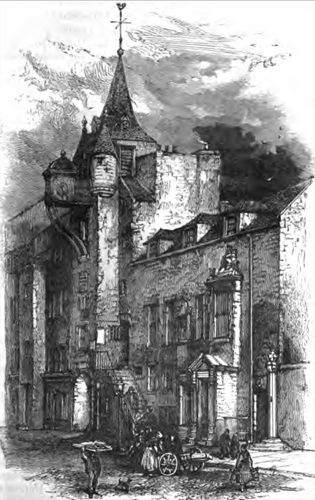 Near Moray House (entering from the Canongate) is St. John Street, where, at No. 13, Lord Monboddo and the beautiful Miss liurnet resided. The poet Burns was a frequent guest here, and the early death of this lady called forth one of his most touching sonnets. No. 10 was the 'residence of James Ballantyne, the printer of the Waverley Novels. Smollett resided for some time in the old house with the tall circular abutment. Another interesting tenement on the same side as Moray House is Playhouse Close, where a stage was established in 1747.
Near Moray House (entering from the Canongate) is St. John Street, where, at No. 13, Lord Monboddo and the beautiful Miss liurnet resided. The poet Burns was a frequent guest here, and the early death of this lady called forth one of his most touching sonnets. No. 10 was the 'residence of James Ballantyne, the printer of the Waverley Novels. Smollett resided for some time in the old house with the tall circular abutment. Another interesting tenement on the same side as Moray House is Playhouse Close, where a stage was established in 1747.
The Canongate Tolbooth or Court-House, represented on the following page, was erected in the reign of James VI. , and is a good specimen of the French style of architecture adopted in Scotland. Over an archway is the inscription — "PATRIE ET POSTERIS, 1591 ;" and on a niche in the building are painted the arms of the Canon- gate, consisting of a stag's head with a cross between the antlers, and the motto — "Sic ITUR AD ASTRA," commemorating the legend of the founding of Holyrood Abbey. The appropriate motto — " ESTO FIDUS," surmounts the inner doorway to the court-house.
In the churchyard of the Canongate Church — a large square building on the same side — are interred Adam Smith the author of The Wealth of Nations, Dugald Stewart, David Allan the artist, and Ferguson the poet. Burns himself erected the simple stone over Ferguson's tomb, "to remain for ever sacred to his memory."
On the opposite side, a Board school for the Canongate district has been erected on the site of Milton House, once the mansion of Lord Milton (1692-1766), an eminent Scotch judge ; and lower down is Queensberry House, now a House of Refuge for the Destitute, named after the nobleman who built Drumlanrig Castle in Dumfriesshire. Here Lady Catherine Hyde, the sprightly duchess of Charles, the third duke, patronised the poet Gay. Sir 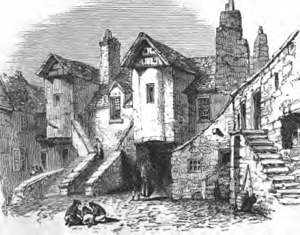 John Whitcford's House, nearly opposite, occupies the site of the palace of the Earls of Wyntoun.
John Whitcford's House, nearly opposite, occupies the site of the palace of the Earls of Wyntoun.
Near the foot of the Canongate, on the north side, are the remains of the White Horse Inn, one of the oldest hostelries in Edinburgh. On the opposite side is the Abbey Court -House, formerly a sanctuary for debtors.
__________
1 Although commonly called Cathedral it is more correctly speaking a Church, hence often called "The High Church." There was no Bishop's chair ( cathedra) before the Reformation.
2 Brass tablets commemorate both the Dean and Jenny; also Robert Lcighton, Bishop of Dunkeld; Gavin Douglas; Craig, assistant to Knox; Alexander Henderson, etc.
3 Duncan Forbes was President of the Court of Session during the troublous period preceding the Rebellion of 1745, and had the sagacity to suggest to Government a measure which would have saved much bloodshed in the Highlands had it been adopted— viz. of enlisting the Highland clans as regiments of the line, a proposal afterwards adopted with advantage.